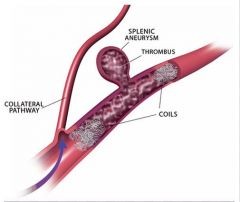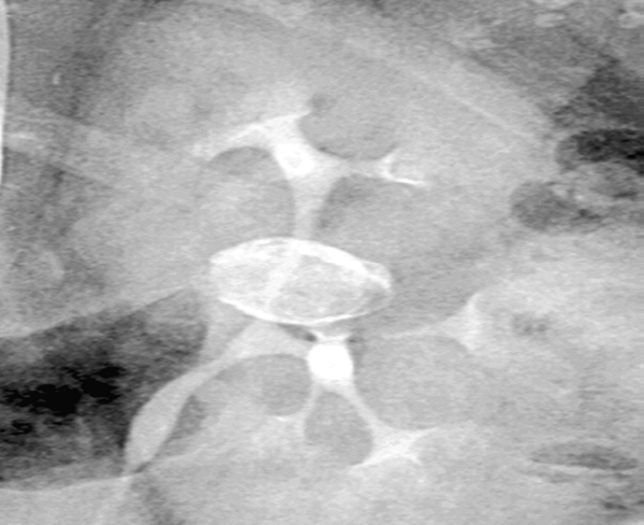Splenic artery aneurysm is the third most common aneurysm in the abdomen and the most common type to affect the internal organs. The spleen is an abdominal organ that forms part of the immune system. It has a large artery that supplies blood to it. When a portion of this artery balloons or widens because of weakness in its walls, an aneurysm develops. Other more common intra-abdominal aneurysms affect the aorta and the iliac arteries.
Are There Any Symptoms of Splenic Artery Aneurysm?
 Initially, most patients do not experience any symptoms, and a splenic artery aneurysm may be diagnosed incidentally on imaging. However, some patients experience nausea, vomiting and abdominal pain. In some patients, serious life-threatening complications like rupture of the aneurysm can occur.
Initially, most patients do not experience any symptoms, and a splenic artery aneurysm may be diagnosed incidentally on imaging. However, some patients experience nausea, vomiting and abdominal pain. In some patients, serious life-threatening complications like rupture of the aneurysm can occur.
Physical examination may be normal, but some doctors note abdominal bruit on auscultation.
Other possible signs and symptoms may include the following:
- Vague abdominal pain and nausea/vomiting.
- Compression symptoms affecting adjacent organs.
- Severe pain on the left side of the abdomen may be due to acute expansion or rupture of the aneurysm.
- Abdominal distension, shock, and death may occur due to rupture into the peritoneum.
- In up to 30% of cases, double-rupture may occur, which means rupture of the aneurysm into the lesser sac, followed by intraperitoneal rupture.
- Rupture involving the splenic vein, the gastrointestinal tract, or the pancreatic ducts.
Causes and Risk Factors
Possible causes include atherosclerosis, portal hypertension due to liver cirrhosis, and pregnancy. Multiparity and pregnancy-associated hormonal effects as well as portal hypertension are believed to cause dilatation of the weak walls of the splenic artery.
Other possible causes include congenital defects such as berry aneurysms and arterio-venous malformations. Acquired conditions like pancreatitis and toxic causes may also result in arterial wall damage.
Risk Factors
Splenic artery aneurysm is more common among women, particularly in patients around 50 years old. Other factors that increase your risk of the disease include:
- Multiple pregnancies
- Lupus
- Pancreatitis
- Polyarteritis nodosa
- Trauma
Diagnosis of Splenic Artery Aneurysm
Advanced technology in abdominal imaging has enabled doctors to diagnose more cases in last few years. Most cases are incidental findings on abdominal imaging of unrelated disorders. Classic findings on plain x-ray include a calcified ring in the left upper quadrant.

Treatment Options for Splenic Artery Aneurysm
For patients who have aneurysms that are at least 2 cm in diameter, endovascular therapy is recommended. Management of large aneurysms may include coil embolization.
Regardless of size, surgical intervention may be indicated for rapidly increasing aneurysms, symptomatic aneurysms, cirrhosis, and presence of aneurysm in premenopausal women.
Treatment options include:
- Endovascular or catheter technique, which is minimally invasive but with optimal outcomes. Since the spleen has a rich blood supply, blocking the main splenic artery can be tolerated. Treatment consists of putting steel or platinum coils into the artery to block the aneurysmal portion. The coils are introduced through a catheter and disturb the blood flow in the artery, causing thrombosis.
- Another option is to implant a stent that excludes blood flow to the aneurysm and channels it through the stent. The technique involves the creation of an arterial access through the wrist or groin. Recovery is quick and most patients are able to go home after a day. The risk of late failure is small with these techniques, but continued observation is important.
- Traditional surgery to close off the artery with a clip or ligature may be done. In some cases, splenectomy (removal of the spleen) may be necessary especially if the aneurysm lies very close to the spleen. These procedures may be performed by doing traditional abdominal incisions or through minimally invasive surgery, using very small incisions and laparoscopy. Patients usually have a slightly longer hospital stay and longer recovery time with traditional surgery compared to those who undergo minimally invasive surgery.
The Rupture Risk of the Splenic Artery Aneurysm
The risk of rupture is relatively small (6%), but when it ruptures, the mortality rate is high (36%). Spontaneous rupture of splenic artery aneurysms that are asymptomatic and are less than 2 cm in diameter is rare, especially in patients with no risk factors. A follow-up period of one year is recommended, but it may be extended if other medical risks are present.
